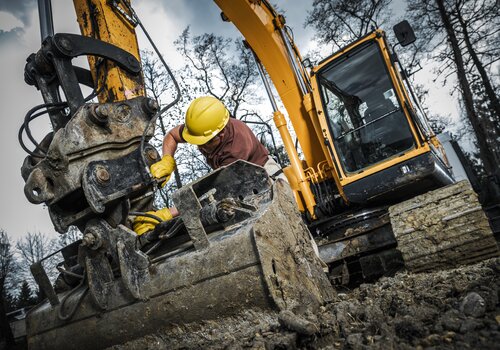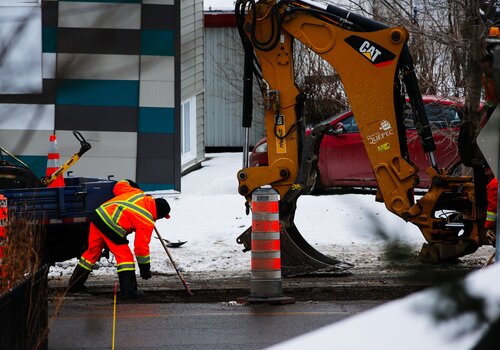Large earthmoving projects are full of challenges and demand large equipment. Most large earthmoving projects either use scrapers or excavators and rock trucks.
“I prefer to use large excavators and rock trucks,” says Lou DeVuono, project supervisor, MGI Construction Corp. (MGI). Even when doing large open cuts, such as excavation for subdivision developments, DeVuono says his preference is for large excavators and rock trucks. The company uses 30- to 40-ton truck rock trucks, 30+-ton excavators and a few 40-ton excavators with long reach capabilities for deep digging.
“Scrapers are limited in their applications. When you’re buying new equipment, you want to get the most bang for your buck and rock trucks perform in more applications than scrapers. Dollar-wise, it makes more sense to use the excavator and rock truck combination.”
One of the challenges is tracking how much earth you have moved and whether you are moving enough to keep to schedule. Some companies use payload technologies, while others use topography (topo).
“We use a drone,” says DeVuono. “It is better to look at area covered or area prepared in order to determine your progress and see if you are meeting your criteria. Topos tend to be more accurate than counting loads, because different materials have different volumes. It becomes material specific.”
“Efficient earthwork operations require a frequent set of ground truth data throughout the project to ensure success”, says Jason Nichols, Product Marketing Manager, Kespry. “Kespry provides a single survey solution that allows contractors to frequently collect accurate site survey data as often as they need. A complete earthwork tool set empowers project managers, surveyors and site superintendents to quickly calculate cut and fill changes and verify compliance of design plans. The result of having access to frequent and accurate earthwork data enables companies to make more money by better managing earthwork operations and ensuring work they have performed is backed up by accurate documentation.”
When to Deviate from Standard Practices
One thing that can change excavation methods is the discovery of something under the ground, such as a utility line. A line strike from an excavator or a backhoe could seriously impact your ability to complete the job as planned and possibly even injure or kill the operator. In which case, you will need to employ a vacuum excavator to locate the utility; it excavates using water, which won’t damage a pipe or electrical line when it makes contact with it. Then you stake out where the line is and continue to employ mechanical digging
Also, earthmoving projects sometimes come across items of historical significance buried in the ground. In which case, excavating operations need to take a more careful approach and this will probably require different equipment or more manual labor instead of equipment.
“Weather is the number one reason for changing excavation methods. It has the largest effect on your excavation and engineering of materials,” says DeVuono. Wet, rainy conditions can impact the material itself and wet material is harder to work with; ponds form and you have to remove water from areas of the jobsite. It creates soft and slick conditions that make it difficult for equipment to get around.
Snow and ice is another challenge. “You could be getting into special applications, such as using rippers or frost heads to break through frost layers. The equipment is cold, breakdowns are more likely to happen,” says DeVuono.
Soil conditions can also change your excavation plan. “Certain underlying soils can impact your fills, such as clays or shales or wet material, then you have to excavate the material and then engineer up to get a solid base. There have been times where we have had poor soil conditions but we had a significant fill, so we were able to bridge over top of the soil, which saves a lot of unnecessary excavation and engineering.”
Like anything else in construction, you have to be fluid, says DeVuono. Any minor condition can affect your excavation fill and engineering process. “You need to be able to make adjustments in how you approach a project. So, one day, you get rain, so you have to clear out the surface of the site. Then you engineer up. And, if you engineer that wet material into the engineered material then you don’t need to pile up wet material. By making adjustments, you take advantage of the situation and keep progressing.”
Using Grade Control for Greater Efficiency and Accuracy
Grade control enables operators to meet grade the first time. It is the best solution for avoiding overcutting/undercutting and for reducing rework. Grade control is available on excavators, dozers and motor graders.
Grade control is a form of automation that makes it easy for excavator operators to create smooth, flat or sloped surfaces. For example, on an excavator equipped with Trimble Earthworks, the operator controls the stick, and Trimble Earthworks controls the boom and bucket. “This helps operators stay on grade, reduce overcut and increase production,” says Scott Crozier, general manager of Trimble’s Civil Engineering and Construction Division. “By automating excavator operation, operators can achieve grade consistently, with high accuracy and in less time.”
“The technology is getting better and the accuracy is improving,” says DeVuono. “There are some down sides to it. GPS is good on large open cuts where equipment has access to the sky, so when you are working under a cover or near a building, GPS accuracy goes down significantly.”
Industry experts share seven ways to best utilize grade control technology on mass excavation projects:
1. Calibrate grade control systems on site. Although manufacturers are producing machines they claim don’t need to be calibrated once received by the customer, grade control technology manufacturer recommends that you do. “Grade control technology isn’t as easy as ‘setting it and forgetting it’. There is a lot of calibration to do to the machines and systems in order for them to work as designed or as precisely as they should,” says Gabriel Grenier-Baird, Marketing Manager, Hemisphere GNSS.
2. Use mastless grade control systems for greater productivity. Large earthmoving projects typically require large amounts of equipment. “John Deere’s integration of grading technology products eliminates time spent installing and removing GNSS receivers daily,” says Sean Mairet, grade control product marketing manager, John Deere. “With a large amount of machines on these jobsites, the productivity gained running machines rather than setting them up and shutting them down every day is substantial.”
3. Grading technology is not just for big machines. Skid steer loaders, compact track loaders and mini excavators can often be equipped with grade guidance systems. “A guidance/indicate-only system is designed to ‘indicate’ operating parameters to an operator—usually a laser-based system that will beep and/or flash when a predetermined digging or grading parameter has been met or exceeded,” says Max Winemiller,
now the Head of Heavy Equipment Product Management & Marketing, Case Construction Equipment. It isn’t quite machine control, because all functions need operator input; it simply guides the operator in reaching the target grade.
4. Train your grade control operators on grade control technology. “The more experience the operator, the better,” says DeVuono. “A lot of operators are younger; they didn’t grow up in the industry; they are growing into the industry. The people who graduate from heavy equipment training schools may know how to operate a machine, but they don’t understand job expectations. That can effect a project as much as weather or soil conditions.”
Many original equipment manufacturers say an operator can learn how to adequately operate grade control on a machine in 10-20 minutes. Once your operator is trained on grade control, grade control will significantly improve the performance of your operator.
5. Customize and save your digging profiles and operator preferences. It is faster and easier to use a pre-saved digging profile than to create a new one; it also leads to less operator error, which results in over or under cutting. More proficient operators can learn to. draw custom digging profiles directly from the cab without the need for an on-site engineer or surveyor, saving time and labor costs.
6. Upgrade to 3D for more complex jobsites. A 2D grade control system works well on flat planes and slopes and on jobsites that don’t change much. “Anything and everything can happen that will change how you move earth,” says DeVuono. If the job requires cutting contours or complex curves or if the job changes frequently, a 3D grade control system will serve you better.
7. Link your grade control technology with the surveys conducted by your drones. Land surveys collected from construction drones, also known as drone mapping, are especially helpful for large-scale earthmoving projects. Manufacturers are increasingly incorporating this technology into their grade control systems, providing the ability to rapidly acquire accurate data needed for bidding, productivity tracking, inventory management, and project verification, which are key to large earthmoving projects.
Subscribe to the CONEXPO-CON/AGG 365 weekly newsletter to receive more insightful stories like this.












